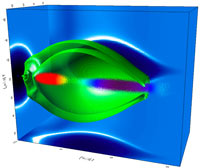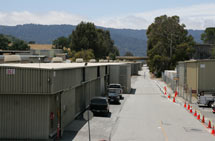
Handy Links
SLAC News Center
SLAC Today
- Subscribe
- Archives: Feb 2006-May 20, 2011
- Archives: May 23, 2011 and later
- Submit Feedback or Story Ideas
- About SLAC Today
SLAC News
Lab News
- Interactions
- Lightsources.org
- ILC NewsLine
- Int'l Science Grid This Week
- Fermilab Today
- Berkeley Lab News
- @brookhaven TODAY
- DOE Pulse
- CERN Courier
- DESY inForm
- US / LHC
SLAC Links
- Emergency
- Safety
- Policy Repository
- Site Entry Form

- Site Maps
- M & O Review
- Computing Status & Calendar
- SLAC Colloquium
- SLACspeak
- SLACspace
- SLAC Logo
- Café Menu
- Flea Market
- Web E-mail
- Marguerite Shuttle
- Discount Commuter Passes
-
Award Reporting Form
- SPIRES
- SciDoc
- Activity Groups
- Library
Stanford
Around the Bay
FACET: Toward the Tabletop Accelerator
A new experimental facility aims to shrink the size—and costs—of future particle accelerators. The Facility for Advanced Accelerator Experimental Tests, or FACET, will leverage decades of leading accelerator science at the Department of Energy's SLAC National Accelerator Laboratory to develop next-generation technology. Initial research and development for the project got a boost this spring, in the form of $2 million of support from the American Recovery and Reinvestment Act.
The FACET team dreams of linear accelerators that are much more compact than the existing SLAC linac—even thousands of times more compact. "You could take our entire two-mile linac and double its energy in just one additional meter," said project manager Andrei Seryi. Though this new concept is still theoretical, FACET will use part of the SLAC linac to test the principle that will make it possible: plasma wakefield acceleration.
Here's how it works: The linac zips a compressed bunch of electrons about a tenth of a millimeter long down its length. A small piece of metal called a notch collimator splits the bunch in half, leaving two identical bunches. The first bunch, called the "drive bunch," rams into a cloud of gas, stripping its atoms of electrons and creating an ionized gas, or plasma.
"You can think of the drive bunch creating a wave in the plasma," said SLAC physicist Mark Hogan, who leads the scientific program at FACET. "The picture everybody uses is that the accelerated electrons are surfers and they're riding the wave." Because the electrons in the bunch and the electrons from the gas are both negative, they repel each other and the electrons in the gas are driven out of the bunch's path. The drive bunch leaves positively-charged ions in its wake. This attracts the electrons from the gas, so that they return and gather just behind the second, "witness" bunch as it travels through. The electrons from the gas repel those in the witness bunch, pushing it forward with a very high accelerating gradient. In this way, the drive bunch transfers its energy to the witness bunch, all in the space of about one meter.
The research at FACET will explore both acceleration and beam quality, and demonstrate a single stage of a plasma acceleration reaching energies as high as 25 GeV. The next generation of accelerators may use several such plasma stages in a row, adding the energy from as many as 20 drive bunches to a single witness bunch, to attain enormous energies in cramped quarters.
"This concept shrinks the linac length down by at least a factor of ten, and the cost down by a factor of anywhere from five to ten," Hogan said.
The idea of using plasma to accelerate electrons was demonstrated in single-bunch experiments using SLAC's Final Focus Test Beam facility, by a collaboration from SLAC, the University of California, Los Angeles, and the University of Southern California. The collaboration plans a detailed experimental program at FACET, and the FACET team is in active discussions with other interested scientists from across the country. Experiments under consideration range from fundamental acceleration concepts to studies of beam interactions with crystals or material damage with FACET's ultra-intense beams.
FACET will also push the frontiers in solid-state physics and basic energy science. The intense beam fields could be used to study magnetic switching in materials used for recording devices, which could make speedier hard drives. Furthermore, if the plasma wakefield acceleration concept works, it might be used to double the energy of the Linac Coherent Light Source with just 30 cm of plasma—a thrifty route to higher energies compared to current technology. "This could be a great savings, though of course it's still a very preliminary concept," Seryi cautioned.
In addition to electron accelerators, pioneering high-energy physics requires colliders that smash electrons and positrons together. Plasma wakefields can accelerate positron as well as electron bunches, using electron driving bunches. But in the SLAC linac, the drive bunch and witness bunch are too far apart. To bring them closer, FACET will use a new technology called a sailboat chicane: a U-shaped series of magnets. The leading positron bunch traces the entire length of the U, while the electrons skip along the top. The electrons reach the end of the chicane first, and the positrons slip into position a tenth of a millimeter behind, perfectly poised for acceleration.
"SLAC is one of the few places in the world that makes positrons, but we'll be the only place in the world that has high-energy positrons with the short bunch lengths necessary for plasma wakefield acceleration, and thus the only place where you can study them." Hogan said. "Positrons are mostly unknown territory."
To proceed from concept to the complete facility, the project faces several DOE reviews, with the next one in late July. If all goes well, the team hopes to begin construction in October, and see the first electrons within the next two years.
—Lisa Grossman
SLAC Today, July 2, 2009

